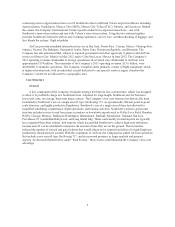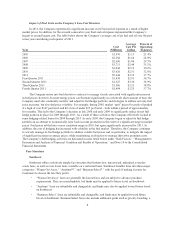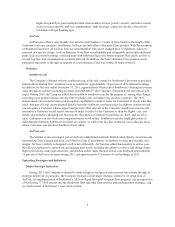Southwest Airlines 2011 Annual Report Download - page 19
Download and view the complete annual report
Please find page 19 of the 2011 Southwest Airlines annual report below. You can navigate through the pages in the report by either clicking on the pages listed below, or by using the keyword search tool below to find specific information within the annual report.In addition, the Company has taken significant steps towards Required Navigation Performance (“RNP”)
operations. RNP is one of the cornerstones of the FAA’s strategy to modernize the U.S. Air Traffic Control
System by addressing limitations on air transportation capacity and making more efficient use of airspace. RNP
combines the capabilities of advanced aircraft avionics, GPS (Global Positioning System) satellite navigation
(instead of less-precise ground-based navigation), and new flight procedures to (i) enable aircraft to carry
navigation capabilities rather than relying on airports; (ii) improve operational capabilities by opening up many
new and more direct approach paths to produce more efficient flight patterns; and (iii) conserve fuel, improve
safety, and reduce carbon emissions. Southwest began developing GPS approach procedures during the first
quarter of 2010, completed RNP training of nearly 6,000 pilots in November 2010, and commenced RNP
procedures in revenue service in January 2011. In the first twenty days of RNP activation, Southwest performed
1,400 RNP approaches, and, by the end of 2011, Southwest had conducted 6,790 RNP approaches; however, for
reasons out of its control, Southwest’s total number of RNP approaches has slowed to fewer than 400 per month.
Southwest must rely on RNP approaches published by the FAA, and the rate of introduction of RNP approaches
has been slower than expected, with RNP approaches currently available at only 17 airports. In addition, even at
airports with approved RNP approaches, the clearance required from air traffic controllers to perform RNP
approaches is often not granted. As a result, in the second half of 2011, the Company decided not to equip its
Classic (737-300/500) aircraft with RNP capabilities.
Wireless Ramp Communication
In December 2011, the Company announced that Southwest will be the first U.S. airline to equip ramp
Employees systemwide with hands-free wireless headsets to enable the ground crew and pilots to verbally
coordinate the process of pushing back planes from concourse gates. The new devices are expected to add
another level of safety to potentially dangerous situations. The headset system could also potentially help to
improve departure times and fuel efficiency. The Company expects the headset system to be deployed at all
Southwest gates nationwide during the first quarter of 2012.
Management Information Systems
The Company has continued its commitment to technology improvements to support its ongoing
operations and initiatives. During 2010, the Company completed the integration of a new SAP Enterprise
Resource Planning application, which replaced the Company’s general ledger, accounts payable, accounts
receivable, payroll, benefits, cash management, and fixed asset systems. The conversion was designed to improve
the Company’s key business processes by implementing an integrated tool to increase efficiency, consistency,
data accuracy, and cost effectiveness. In addition, the Company has invested in significant technology necessary
to support its All-New Rapid Rewards frequent flyer program, enhanced southwest.com website, and WiFi
implementation. The Company intends to continue to devote significant technology resources to accommodate
the introduction of the 737-800 into the Southwest fleet and to implement a new reservation system that will
allow the Company to add international destinations and improve revenue management and Customer Service
functionality.
Regulation
The airline industry is heavily regulated, especially by the federal government. Examples of regulations
affecting the Company and/or the industry are discussed below.
Economic and Operational Regulation
The U.S. Department of Transportation
The U.S. Department of Transportation (the “DOT”) regulates aviation safety, as well as economic,
consumer protection, and civil rights matters. The DOT may impose civil penalties on air carriers for violating its
regulations.
13
























